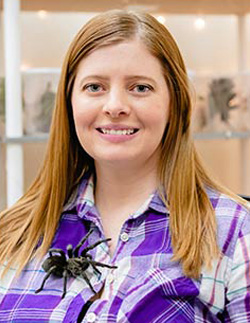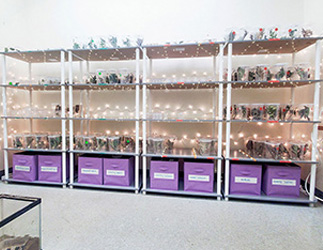Texas nonnative species of the brown widow spider. Photo by Ashley Wahlberg
The Spider Lady of Nacogdoches
Doctoral student contributes to the scientific understanding of toxic spider species
Story by Sarah Fuller '08 & '13
Photos by Gabrielle Czapla '20

Every community has a notable cast of characters who set themselves apart thanks to eccentricities, unique interests or expertise, and Nacogdoches is no exception. One of the most recently recognized local personalities can be found at SFA, inconspicuously wandering the halls of the Miller Science Building.
While many know her as Ashley Wahlberg, lab coordinator for the Department of Biology, other community members know her simply as "the spider lady."
Following a post on a Nacogdoches community Facebook page indicating Wahlberg would gladly collect widow spiders found near local homes, requests poured in, and a moniker was born.
"I posted about it enough that people began asking, ‘Isn't that spider lady somewhere on this page — can she tell me what this spider is?'" Wahlberg said. "People I don't know started tagging me in posts, and the name just kind of stuck."

While hand-collecting one of North America's most toxic spider species may sound grossly unappealing to many, Wahlberg, currently pursuing a doctoral degree in forestry at SFA, has good reason to do so.
Under the direction of Dr. Jessica Glasscock, assistant professor of wildlife in SFA's Arthur Temple College of Forestry and Agriculture, Wahlberg is shedding much-needed light on how the nonnative brown widow spider successfully established itself in Texas, as well as how the species may affect native black widow spiders.
According to the Texas Invasive Species Institute, more than 800 aquatic and terrestrial nonnative species have been introduced to the state, and that number is only expected to increase.
Wahlberg said brown widows have been detected in close to 50 Texas counties, with concentrations centered around the cities of Houston, Austin, San Antonio and Brownsville.

Photo by Ashley Wahlberg
Thought to originate from South Africa, brown widows are variable in color, ranging from light brown to black. Like the black widow, the tell-tale hourglass marking is present on the brown widow's abdomen, although it typically boasts a vibrant orange hue rather than red.
To showcase this color variability, Wahlberg delicately opened a plastic receptacle and removed a web-covered leaf containing a brown widow. The spider, roughly the size of a dime, barely stirred.
As for her concern of being bitten by either venomous species, Wahlberg simply shakes her head and explains that bites are very rare, and neither species is aggressive.
"Most of the work with brown widows has taken place in California because there are two really popular spider experts there who have done a lot of work," Wahlberg said. "There's a little bit of research from Florida, but everything else is anecdotal occurrence records — there's not actually any research investigating how they're interacting with the environment."
The room housing Wahlberg's roughly 2,000 study subjects is quiet, organized and equipped with delicate white Christmas lights that add ambiance.
"The lights are on a 12-hour day-to-night cycle," Wahlberg explained. "They come on at 8 a.m. and turn off at 8 p.m. Many animals rely on having a circadian rhythm in order for them to function properly."

Photo by Ashley Wahlberg
In this room, Wahlberg completes the delicate task of dissecting egg sacs of the two widow species. While the egg sac of the black widow is smooth, the brown widow's is equipped with small spikes.
Much information can be gleaned from the contents of these egg sacs, and Wahlberg is specifically looking to discover whether brown widows are less impacted by the same parasitic flies and wasps that prey on the egg sacs of the black widow.
The parasitoid wasps and flies that prey on these eggs aren't the commonly seen wasp or house fly — they are much smaller.
Wahlberg explained that the two specific parasitoids she is investigating, the eurytomid wasp and the chloropid fly, lay their eggs on fresh spider egg sacs. Subsequently, those hatchlings devour the contents of the spider egg.
"Since these parasitoids didn't coevolve with the brown widows, they may not see them as a host," Wahlberg said. "We will collect and dissect at least 1,000 egg sacs, and the parasitoids within each sac will be counted and identified when possible."
In order to reach that staggering number of samples, Wahlberg actively collects and breeds both species of spider in addition to teaching anatomy and physiology, as well as other biology classes when needed.
"I tell my students on the first day of class that if you come to my office, you're going to see spiders. If you see me walking around campus looking in windows, I'm looking for spiders — just ignore me," she said with a laugh.
Wahlberg's current research isn't her first experience with venomous or reviled species. Prior to joining the SFA staff, Wahlberg was an education and outreach specialist with Texas Snakes and More, a Houston-based business focused on engaging and educating the public on snakes and their critical role in the ecosystem. It was there she met her husband, Scott '13, who earned a degree in forestry from SFA.
Wahlberg earned a Bachelor of Science in wildlife biology and a Master of Science in biology from West Texas A&M University in Canyon. During her time there, she researched amphibians and conducted rattlesnake surveys for private landowners.
"Whenever I went to college and started taking wildlife classes, I very quickly realized that everyone tends to focus on deer or game birds," Wahlberg said. "I thought, I don't want to be like everyone else — that's not exciting."
After completing a course in arachnology, the scientific study of arachnids, including spiders and related animals, Wahlberg found an entirely new passion.

"I wanted to work with something we don't know a lot about," Wahlberg said. "There are 34 species of widow spiders throughout the world, and you can only find published articles on maybe a dozen of those. Some species have no information available at all."
As if her dedication to years of collecting and researching widow spiders wasn't enough to earn her spider lady designation, a tattoo of a brown widow adorns Wahlberg's right shoulder. Further, her office shelves are home to her many venomous pet tarantulas of varying species, as well as Eastern hognose and king snakes thrown in for good measure.
"A lot of people's understanding or view of widow spiders would change if they got to just come in and see them in person," she said.
According to Wahlberg, research indicates proteins extracted from the venom of both snakes and spiders can be useful in the formulation of medicines to treat Alzheimer's disease, high blood pressure and cancers, as well as in pain management.
Wahlberg's research has garnered statewide attention, appearing in Texas Monthly, as well as "The Michael Berry Show" and Houston Public Media. A true advocate for arachnids, she doesn't hesitate to share her knowledge.
"I know people are taught to be scared of spiders, but between their venom helping with all kinds of medicines and all of the bugs they eat, they are extremely beneficial," Wahlberg said. "Half the time you're walking past them, and you have no idea they're there."
Profile image caption: The velvety Brazilian Black tarantula poses with Ashley Wahlberg in her office in the Miller Science Building. Wahlberg acquired this female specimen in 2018 when she was just a few months old and very tiny. This tarantula is now about 7 inches long and should live about 20 years. Male lifespans are much shorter, about six to eight years.
 Axe ’Em, Jacks!
Axe ’Em, Jacks!
